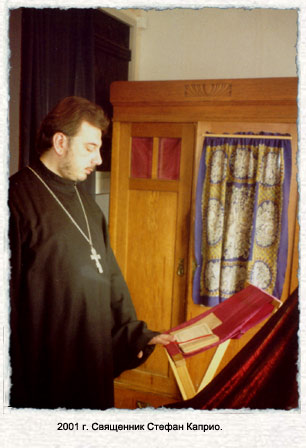|
KROTOV'S DAILY
February 16, 2002, Moscow, 8.57
Tue Feb 12, 2:06 PM ET
By SARAH KARUSH, Associated Press Writer
 VLADIMIR,
Russia - On a wintry Sunday in a small Catholic church, the Rev. Stefano Caprio's
deep voice resonates from the altar, carrying Russian words flavored with a melodic
Italian accent toward the congregation. VLADIMIR,
Russia - On a wintry Sunday in a small Catholic church, the Rev. Stefano Caprio's
deep voice resonates from the altar, carrying Russian words flavored with a melodic
Italian accent toward the congregation.
The distinctive sound of Caprio celebrating Mass in the city of
Vladimir is symbolic of Roman Catholicism in Russia, where some
200 foreign priests are helping to revive a community nearly snuffed
out by 74 years of communism.
Their presence has riled the dominant Russian Orthodox Church,
which contends Catholic priests are importing an alien faith and
attempting to lead people away from Russia's native church, itself
recovering from decades of Soviet repression.
The Catholic Church's activities in Russia took on a new permanence
Monday, when the Vatican elevated its apostolic administrations
there to full-fledged dioceses. The more informal structure gave
the church the flexibility it needed to operate during the communist
era, but now, the church says, dioceses can better perform pastoral
duties. The new structure also allows closer Vatican control.
The Russian Orthodox Church reacted angrily to the announcement,
and the Orthodox Church's chief of foreign relations, Metropolitan
Kirill, told Russia's RTR state television his church would likely
stop all contacts with the Vatican indefinitely.
Tension intensified last summer when Pope John Paul II visited
Ukraine. The pope has long expressed a desire to come to Russia,
but the head of the Russian Orthodox Church, Patriarch Alexy II,
says he will oppose a papal visit as long as the Catholic Church
continues its alleged proselytizing on Russian soil.
In Vladimir, about 100 miles east of Moscow, the spire of the 108-year-old
Our Lady of the Holy Rosary shares the skyline with the golden onion
domes of ancient Orthodox churches.
To Catholic parishioners, there is nothing foreign about their
church. And Caprio, who came to Vladimir in 1994, has become a vital
part of the community.
"This church answered my needs," said 42-year-old Irina Ignatyeva,
adding she was drawn to Catholicism because of her Polish great-grandmother.
Before the 1917 Revolution, Catholic worshippers here were primarily
foreign traders. Today, the majority of the 500 parishioners are,
Caprio said, "ethnic Catholics" � Russians with Polish, Belarusian,
Lithuanian or German roots.
During the Soviet era, Our Lady of the Holy Rosary was converted
into apartments and then into a museum, and its bell tower became
a radio relay center.
On a recent Sunday, about 100 people packed the church for Mass.
Afterward, younger parishioners performed humorous skits as a birthday
surprise for Caprio, who turned 42 the next day.
Prior to 1917, Catholics in Russia numbered about 800,000. In 1991,
when the church began restoring its structure under the leadership
of Archbishop Tadeusz Kondrusiewicz, there were only 10 parishes
and eight priests.
Kondrusiewicz now puts the number of Catholics in the country at
about 600,000. There are 212 parishes and nearly 300 small, unregistered
communities. In 1999, the first priests were ordained in post-Soviet
Russia, and today about 15 percent of the country's 275 Catholic
priests are Russian, Kondrusiewicz says.
The Catholic Church says it is merely restoring what existed before
the revolution and cannot be accused of invading Orthodox territory.
"They are lying when they talk about proselytizing.... I have never
heard a concrete example," Caprio said, anger rising in his voice.
"The Orthodox Church's main mistake is that it has always defined
itself in opposition to an enemy."
Despite the arguments between the Catholic and Orthodox hierarchies,
church relations in Vladimir are friendly. Caprio and the local
Orthodox bishop visit prisons together, and the churches are building
an interfaith youth center.
This contrasts with other regions, where local officials' have
favored Orthodox churches and prevented Catholic parishes from reclaiming
church property.
The Rev. Maxim Kozlov, an Orthodox priest who teaches comparative
theology in Moscow, says the number of so-called ethnic Catholics
in Russia does not justify the extent of Catholic Church activity.
He says the church is looking toward Russia to renew its flock and
recruit priests.
"They build churches in (the Siberian cities of) Irkutsk and Novosibirsk
on the basis of 'there once was a church here,'" Kozlov said. "But
the Poles and Germans are long gone from those places."
Some worshippers say they felt drawn to Catholicism, which differs
from Orthodoxy not only in theology, but also in more tangible ways.
During the Orthodox liturgy, congregants stand in an often dark
church filled with the smell of candle wax. Women must wear skirts
and cover their heads. The liturgy is said in Church Slavonic, a
relative of Russian not immediately understandable to Russians without
religious education.
At Holy Rosary, light streams in the windows and congregants sit
for most of the Mass. Many women wear pants, and the language is
Russian.
"Here there is real faith without abridgment of freedoms," said
Yulia Popkova, Holy Rosary's 24-year-old choir director, who said
she joined the church after becoming disillusioned with her Orthodox
parish.
|


